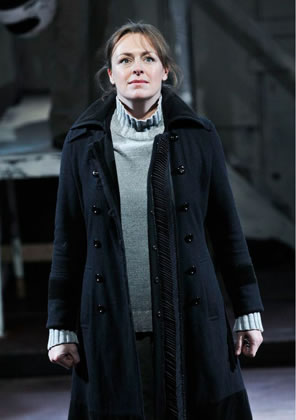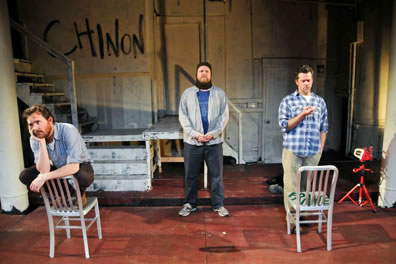Saint Joan
Taking Theater to the Dimension of Our Selves
By George Bernard Shaw
Bedlam, Lynn Redgrave Theater, New York, N.Y.
Saturday, February 15, 2014, "Premium Seats" at various locations
Directed by Eric Tucker
It is usually the likes of Shakespeare and Sophocles who inspire modern takes and experimental theater, not Shaw. So it is with a bit of chutzpah and ingenuity—and, yet, perfect logic—that Bedlam is producing George Bernard Shaw's Saint Joan with a cast of four in a fluid theater space.

Andrus Nichols as Saint Joan in Bedlam's production at the Lynn Redgrave Theater. Photo by Jenny Anderson, Polk & Co.
Under Eric Tucker's direction, the ensemble succeeds in delivering Shaw's sharp-witted, sprawling masterwork—sprawling in both a dramatic and ideological sense, not to mention his elaborate stage settings that this production foregoes—while giving the audience an inclusive, visceral theatrical experience. The 1923 play, one of Shaw's best, stands on its own as the playwright uses the story of Joan of Arc to debate women's rights versus cultural traditions, grassroots nationalism versus feudal order, and individual spirituality versus religious doctrine. Great acting, such as that on display in this production, brings the play's wordy dialogue to life, and ratcheting up the experience is Bedlam's staging, which not only puts us inside the play, it puts Shaw's play inside us.
Shaw closely follows the historical record for the play's plot, but his characters are Shavian archetypes: the self-assured Joan pursuing her visions with naive logic; the ultrapractical professional soldier Dunois; the Earl of Warwick behaving more like a Tory operative in Parliament than a medieval baron; the bullied Dauphin; and the churchmen, ranging from the bishops with their ecclesiastical spiritualism to the local village rectors, represented in this play by a chaplain and canon, with their narrowminded despotism. Though Shaw certainly had his socialist and women's lib views, he lets nobody off the hook in this play. Meanwhile, the cast rises above even Shavian stereotypes, which is all the more creditable in that the three men play multiple roles, sometimes simultaneously.
Andrus Nichols is Joan, first appearing as a rambunctious teen-ager bursting with expectation based on absolute faith. Nichols never lets go of Joan's enthusiastic bent to the end of the play—in the poignant epilogue, she remains the wide-eyed teen-ager as she's being sainted—but she does blend into her portrayal an increasing sensibility and encroaching wariness. She's downright weary when she appears for her trial and caves in to the arguments of the church authorities in utter confusion. Ironically, a blast of realism and human yearning helps her regain her faith, and she's stouter than ever as she's escorted out to the stake for burning. Joan is accused of being stubborn and proud, and in Nichols' playing she becomes so—even her statements of humility come across as vain pride—though her cockiness comes from the certainty of her faith in God and the voices she hears.
Warwick is the political maneuverer behind Joan's capture and subsequent death, and Tucker, in natty tattersall jacket and his nose tilted at an uppercrust angle, plays him as the consummate slimy politician. Yet, the things he says make perfectly practical sense, and Tucker's delivery of these lines without a hint of malice begins to wear down our resolve to hate him. By the end, when he admits he was right in theory but wrong in practice, we even have some empathy for the man. Tucker also plays Jack Dunois, but as a rugged, man's man whose straightforward masculinity appeals to Joan, not on a sexual basis so much as that of a young soldier looking up to the experienced commander. Tucker's Dunois treats Joan as a kid sister, but he always puts practicality ahead of sentimentality, even as he acknowledges her superior generalship.
Tom O'Keefe does double duty as the ecclesiastical churchmen: the French Archbishop and Monseigneur Cauchon (Bishop of Beauvais), as well as Joan's first convert, Bertrand de Poulengey, "Polly," the baron soldier. The bishops in this play may be bound to church hierarchy, but O'Keefe nevertheless makes them genuinely spiritual and caring. Their faith is as strong as Joan's, but whereas God has spoken directly to Joan through the saints, God has spoken to the church leaders via centuries of doctrine.
This production combines Chaplain De Stogumber and Canon de Courcelles into a single character played by understudy Stephan Wolfert (filling in for Edmund Lewis), who also plays The Dauphin, later Charles VII—or "Charlie" to Joan who treats people of all classes as equals. Wolfert gives each of his characters a distinctive personality, from the sniveling cowardice of Charlie to the vicious and jingoistic pathology of Stogumber/Courcelles, while making both cowardice and viciousness comical.
In both the first French court scene and in the inquisition scene, the three men end up trading off roles, taking over each other's lines and speaking in accents and postures specific to each character; in the latter scene they add into the mix a gently rendered Brother John Lemaître as the Chief Inquisitor. Adhering to the structure of the scene's banter is more important to director Tucker than gluing a character to a single actor, for it points to the very ubiquitousness of the politicians and churchmen.
The production further blurs the lines divining the play's various theological, political, and social positions while making the characters too sticky for us to shake away thanks to its setting: today and us. All the characters are played in modern dress—indeed, as no costume designer is credited, the characters' clothes may have come from the actors' own closets (if so, I want to know where Nichols shops, because her Joan wears a sumptuous classic black overcoat as her soldier's uniform). Not only is a modern rendering of Shaw palatable, it's preferable for such a production as this, as we become the inquisitors during the trial, and then Joan becomes us.
Shaw may have been using the Joan of Arc tale to reflect on his own times, but the arguments are just as relevant and perhaps more troubling to our own. Really, how comfortable are any of us, even those accounted "people of faith," with an individual who hears voices? Who comes to us with messages direct from God? Who manages to gather followers and succeed based on those messages? Who is, no less, a teenage girl? Thus, how many of us would then side with Warwick? The Dauphin is a comically pathetic character in his cowardice, but his cash-strapped monarchy, indebted to the "bullying" barons, touches upon the political helplessness many people in many nations, including the United States, feel today. Joan's nationalism argument sounds antiwar on the one hand but distinctly dangerous on the other, especially in today's global market, which is erasing physical, cultural, and—her chief concern—language borders. The Stogumber/Courcelles character, ridiculous in his narrow-minded politics and black-and-white perspective, generates plenty of laughs, but if you take the character out of the theater and into the headlines, we stop laughing.
Much of this is in Shaw's script and the actors' portrayals, but it is the manner in which Tucker moves us to this point of blurring the theatrical world with the real one that raises the intellectual and emotional stakes of this Saint Joan—and by "move" I mean literally (in one of his productions, Tucker put his audience on rolling grandstands that the cast repositioned between scenes). The Lynn Redgrave Theater is a 300-seat Off-Broadway studio space with the auditorium in a semicircle hugging a bare floor and small platforms up against the stage wall, and this configuration serves for the play's first three scenes up to the first intermission. Then, we are instructed to take our belongings with us into the lobby. We return to find the "premium seats" (purchased at a slightly higher ticket price) on the floor facing toward the auditorium seats, and the play's fourth scene—in which Warwick and the churchmen discuss their desire to corral or kill Joan—takes place amid the audience. We then are instructed to turn our seats around for the subsequent scene in which the French king, archbishop, and generals warn Joan of her imminent danger and the probability of being abandoned by her supporters. After this scene, we again are instructed to leave for the lobby with belongings in hand for the second intermission. On our second return, the entire floor is filled with chairs, and after Joan's trial, we have to turn our seats around for the dream-sequence epilogue.

From left, Eric Tucker, Edmund Lewis, and Tom O'Keefe as the French barons in the court at Chinon in Bedlam's production of Saint Joan at the Lynn Redgrave Theater. Though taking on primary roles, the three actors switched off on many of the parts within scenes. Photo by Jenny Anderson, Polk & Co.
This all might seem a bit of a bother, but it puts us inside the play in a way no traditional proscenium arch or thrust-stage presentation could do. For the trial, the Inquisitor speaks directly to the audience like a judge giving a charge to the jury, and when Joan enters, she sits on one of the small platforms right in front of us. The house goes dark except for a single spot on Joan, and the other three actors, in their various characters, question her from behind and among the audience, their voices coming from us, as if we are the judges. For the epilogue, Joan sits among the audience in the upper seats, and all the play's other characters, whom she now re-encounters in her afterlife, are sitting among the audience on the stage floor. Characters and audience become one theatrical element.
This production is a marvel on so many levels: the fact that, along with Nichols' tackling the emotional journey of Joan's life and afterlife, Tucker, Wolfert, and O'Keefe almost flawlessly manage Shaw's wordy dialogue and extended speeches assigned to 21 roles; the fact that Shaw's 1923 dramatization of events that took place between 1429 and 1431 can so incisively pierce our 2014 consciences; the fact that we ourselves become the stage for this play. This is not so much multidimensional theater as it is transdimensional.
Eric Minton
February 20, 2014
Comment: e-mail editorial@shakespeareances.com
Start a discussion in the Bardroom



 Find additional Shakespeareances
Find additional Shakespeareances